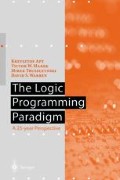Summary
The paper presents an introduction to some of the problems in computational molecular biology (CMB) viewed from a logic programming (LP) perspective. Non-deterministic formal grammars are presented to define biologically interesting subsequences of DNA. Also presented are compact representations of ambiguities by directed acyclic graphs. Various problems in CMB are discussed; their solutions using dynamic programming, hidden Markov models, and inductive logic programming are briefly described. It is believed that a study of these and related problems can contribute to provide a new impetus to LP research and its extensions.
“Biology is so digital, and incredibly complicated, but incredibly useful …I can’t be as confident about computer science as I can about biology. Biology easily has 500 years of exciting problems to work on …”
Donald Knuth in an interview given on Dec. 1993 at the Computer Literacy Bookshops
Access this chapter
Tax calculation will be finalised at checkout
Purchases are for personal use only
Preview
Unable to display preview. Download preview PDF.
References
Books on Computational Molecular Biology
Baldi, P., and Brunak, S., Bioinformatics: The Machine Learning Approach, MIT Press, 1998
Setubal, J., and Meidanis J., An Introduction to Computational Molecular Biology, PWS Publishing, 1997
Salzberg, S.L., Searls, D.B., Kasif, S., (editors), Computational Methods in Molecular Biology, Elsevier, 1998.
Durbin, R., Eddy, S., Krogh, A., and Mitchison, G., Biological Sequence Analysis, Cambridge University Press, 1998
Lander, E.S., and Waterman, M.S.,(editors) Calculating the Secrets of Life, National Academy Press, 1995
Waterman, M.S., Introduction to Computational Biology, Chapman & Hall, 1995
Suhai, S., (editor) Theoretical and Computational Methods in Genome Research, Plenum Press, 1997.
Schulze-Kremer, S., Molecular Biolnformatics: Algorithms and Applications, W. de Gruyter, Berlin-New York, 1996.
Gusfield, D., Algorithms on Strings, Trees and Sequences: Computer Science and Computational Biology, Cambridge University Press, 1997.
Hunter, L., (editor) Molecular Biology for Computer Scientists: Artificial Intelligence and Molecular Biology, MIT Press, 1993
Creighton, T. E., (editor) Protein Folding, W.H. Freeman and Co, 1992
Srinivasan, S., Homology Folding of Proteins, Springer-Verlag, 1998
Lavrac, N., and Dzeroski, S., Inductive Logic Programming, Ellis Norwood, 1994.
Muggleton, S. H., (editor) Inductive Logic Programming, Academic Press, 1992
Books on Molecular Biology
Gonick, L. and Wheelis M., The Cartoon Guide to Genetics, Harper Perennial, 1991
Bailey, J., Genetics and Evolution: The Molecules of Inheritance, Oxford University Press, New York, 1995
Berg, P., and Singer, M., Dealing with Genes: The language of heredity, University Science Books, Mill Valley, CA, 1992
Calladine, C.R., and Drew, H.R., Understanding DNA: The Molecule and How it Works, Second Edition, Academic Press, 1997.
Lewin, B., Genes VI, Oxford University Press, 1997
Freifelder, D., and Malacinski, G.M., (editors), Essentials of Molecular Biology, Second Edition, Jones and Bartlett, 1993
Articles
Searls,D.B. The Linguistics of DNA, American Scientist, v, 80, pp 579–591, 1992
Turcotte, M., Muggleton, S.H., Sternberg, M.J.E., Application of Inductive Logic Programming to Discover Rules Governing the Three- Dimensional Topology of Protein Structure, in Lecture Notes in Computer Science 1446 (subseries LNAI), pp. 53–64, Springer-Verlag, 1998
Hayes, B., The Invention of the Genetic Code, American Scientist, v 86, pp8–14
Holm, L and Sander, C., Mapping the Protein Universe, Science, v 273, pp 595–602, Aug. 1996
Fickett, J.W., Finding Genes by Computer: The State of the Art, Trends in Genetic, vl2, n8, pp 316–320, Aug. 1996
Haseltine, W.A., Discovering Genes for New Medicines, Scientific American, pp 92–97, March 1997
Kardar, M., Which Came First, Protein Sequence or Structure, Science, v273, p 610, Aug. 1996.
Journals
Science, Nature, Journal of Computational Biology, Computer Applications in Biosciences, Trends in Genetics, Journal of Mathematical Biology
Biological Computers
Adelman, L., Molecular Computations of Solutions to Combinatorial Problems, Science, v266, pp 1021–1024, 1994
Adelman, L., Computing with DNA, Scientific American, August 1998, pp 54–61.
Gramss, T. et al, Non-Standard Computation, Wiley-VCH Publishers, 1998
Web Courses Worth Consulting
Primer on Molecular Genetics from the U.S. Department of Energy. http://www.ornl.gov/TechResources/Human_Genome/publicat/primer/intro.html
Stanford Site A course on Bio Informatics offered by the Stanford Medical School and the CS Department. http: //smi-web. Stanford. edu/pro j ect s/helix/mis214/
The MIT Site on Introduction to Biology. http: //esg-www. mit. edu: 8001/esgbio/chapters. html
Yahoo Molecular Biology Page. http://www.yahoo.com/Science/Biology/Molecular.Biology/
University of Washington at Saint Louis. http://www.ibc.wustl.edu/CMB/
Searl’s papers in WWW.http://cbil.humgen.upenn.edu:80/∼dsearls/papers.
Olivier Baby’s Dissertation on Exon-Intron Recognition. http://www.cs.brandeis.edu/∼obaby
Computing with DNA http://users.aol.com/ibrandt/dna_computer.html
Author information
Authors and Affiliations
Editor information
Editors and Affiliations
Rights and permissions
Copyright information
© 1999 Springer-Verlag Berlin Heidelberg
About this chapter
Cite this chapter
Cohen, J. (1999). Computational Molecular Biology: A Promising Application Using LP and its Extensions. In: Apt, K.R., Marek, V.W., Truszczynski, M., Warren, D.S. (eds) The Logic Programming Paradigm. Artificial Intelligence. Springer, Berlin, Heidelberg. https://doi.org/10.1007/978-3-642-60085-2_12
Download citation
DOI: https://doi.org/10.1007/978-3-642-60085-2_12
Publisher Name: Springer, Berlin, Heidelberg
Print ISBN: 978-3-642-64249-4
Online ISBN: 978-3-642-60085-2
eBook Packages: Springer Book Archive

